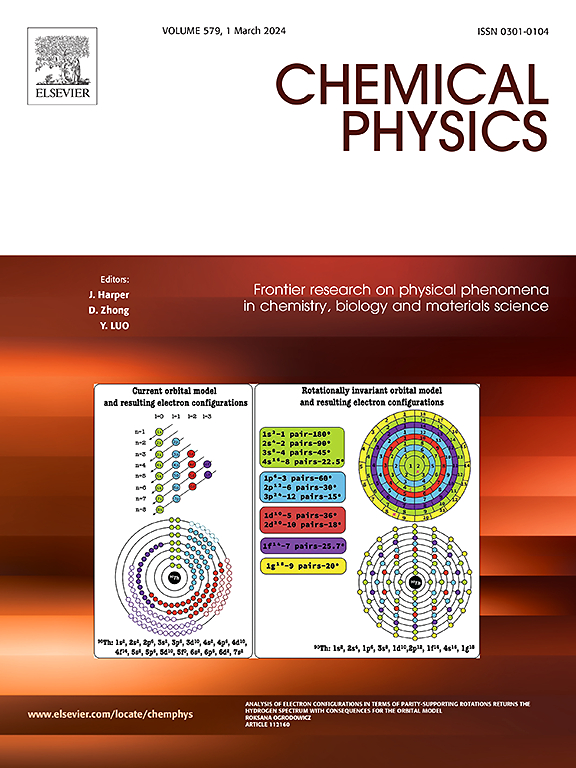DFT研究了掺杂两分子砷化镓的钛锆纳米团簇的第一原理三模型的电子性质
IF 2.4
3区 化学
Q4 CHEMISTRY, PHYSICAL
引用次数: 0
摘要
材料科学通过组合成分创造金属间化合物和合金来提高金属系统的性能。金属合金纳米团簇和掺杂金属合金纳米团簇在电子、工程、催化和医学等领域具有潜在的应用前景。本研究考察了三种钛-锆纳米团簇模型,表示为TinZrn (n =原子数),每种模型掺杂两分子镓-砷。构建的模型包括Ti5Zr4、Ti4Zr6、Ti6Zr9、Ti5Zr4Ga2As2、Ti4Zr6Ga2As2和Ti6Zr9Ga2As2,利用高斯09、DFT计算和B3PW-91,每个模型都有LanL2DZ基集。研究了这些纳米团簇的电离势(IP)、电子亲和力(EA)、偶极矩(DM)、分子硬度(η)、能隙(Eg)、柔软度(S)、电荷(∆Nmax)、结合能(BE)、IR和拉曼活性。结果证实了纳米团簇的稳定性。总之,开发从非导电过渡到半导体的合金可以增强其应用。电子器件,包括晶体管、探测器、传感器、太阳能电池、集成电路和处理器、光学器件和高介电常数材料,它们在制造电容器方面特别有利,如能隙、dm和平均极化率的值所示。本文章由计算机程序翻译,如有差异,请以英文原文为准。
DFT investigation on electronic properties of the first principle three models of titanium-zirconium nanoclusters doped with two molecules of gallium-arsenic
Materials science enhances the properties of metallic systems by combining components to create intermetallic compounds and alloys. Metallic alloy nanoclusters and doped metallic alloy nanoclusters hold potential applications in electronics, engineering, catalysis, and medicine. This study, examines three models of titanium‑zirconium nanoclusters, denoted as TinZrn (n = number of atoms) were doped with two molecules of gallium‑arsenic for each model. The constructed models include Ti5Zr4, Ti4Zr6, Ti6Zr9, Ti5Zr4Ga2As2, Ti4Zr6Ga2As2, and Ti6Zr9Ga2As2 utilizing Gaussian 09, DFT calculations, and B3PW-91 with LanL2DZ basis sets for each model. The study investigates the ionization potential (IP), electron affinity (EA), dipole moment (DM), molecular hardness (η), energy gap (Eg), softness (S), electronic charge (∆Nmax), binding energy (BE), IR and Raman activity of these nanoclusters. The results confirm the stability of nanoclusters. In conclusion, developing alloys that transition from nonconductive to semiconductive enhances it applications. The electronic devices including transistors, detectors, sensors, solar cells, integrated circuits and processors, optical devices, and high dielectric constant materials, which are particularly advantageous in manufacturing capacitors, as indicated by the values of energy gaps, DMs, and average polarizability.
求助全文
通过发布文献求助,成功后即可免费获取论文全文。
去求助
来源期刊

Chemical Physics
化学-物理:原子、分子和化学物理
CiteScore
4.60
自引率
4.30%
发文量
278
审稿时长
39 days
期刊介绍:
Chemical Physics publishes experimental and theoretical papers on all aspects of chemical physics. In this journal, experiments are related to theory, and in turn theoretical papers are related to present or future experiments. Subjects covered include: spectroscopy and molecular structure, interacting systems, relaxation phenomena, biological systems, materials, fundamental problems in molecular reactivity, molecular quantum theory and statistical mechanics. Computational chemistry studies of routine character are not appropriate for this journal.
 求助内容:
求助内容: 应助结果提醒方式:
应助结果提醒方式:


